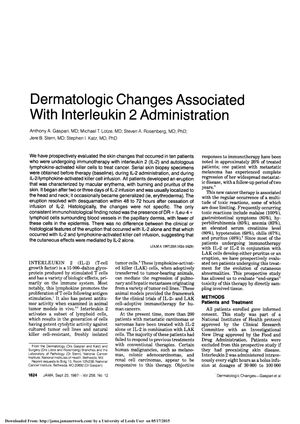Dermatologic Changes Associated With Interleukin 2 Administration
September 1987
in “
JAMA
”

TLDR IL-2 treatment causes skin eruptions and other reversible side effects, and may play a role in psoriasis.
In 1987, a study involving ten cancer patients treated with interleukin 2 (IL-2) and autologous lymphokine-activated killer (LAK) cells reported predictable dermatologic changes. All patients experienced skin eruptions with macular erythema, burning, and pruritus, which began after two to three days of IL-2 infusion and resolved within 48 to 72 hours after cessation. Histological examination showed nonspecific changes but a consistent presence of activated T cells around blood vessels in the papillary dermis. The skin changes were part of a systemic reaction to IL-2, which also caused flu-like symptoms and mild reversible nephrotoxicity, hepatotoxicity, and hematologic toxicity. The study concluded that the skin eruptions were likely due to a capillary leak syndrome induced by IL-2, and while oral antihistamines were somewhat effective for mild cases, histamine was not the sole mediator. The exacerbation of psoriasis in some patients suggested a potential role of IL-2 in psoriasis pathophysiology. The study highlighted the need for physician awareness of these complications as IL-2/LAK therapy trials were expanding.
